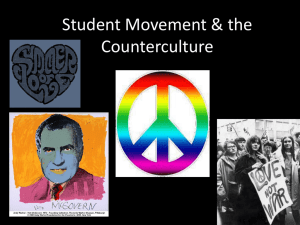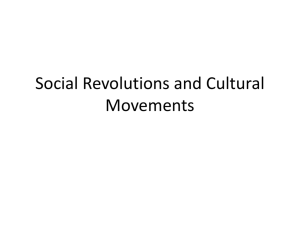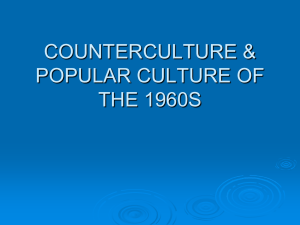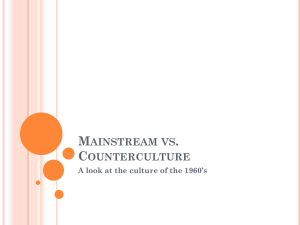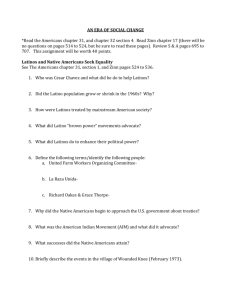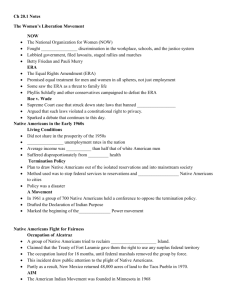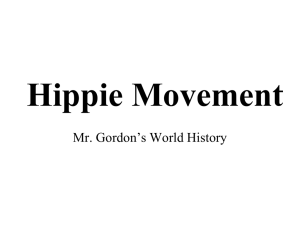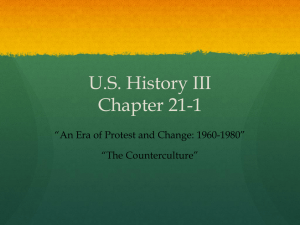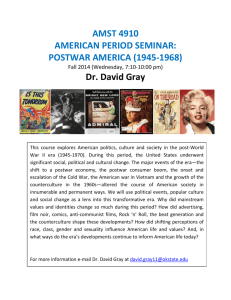60`s and 70`s counterculture article
advertisement
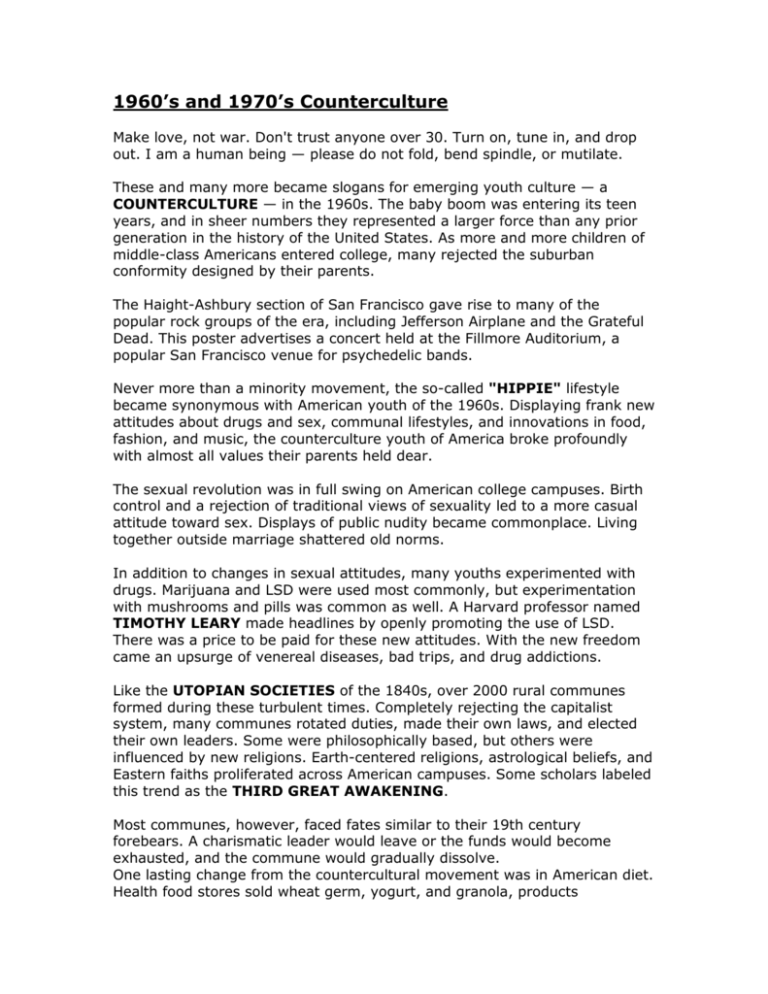
1960’s and 1970’s Counterculture Make love, not war. Don't trust anyone over 30. Turn on, tune in, and drop out. I am a human being — please do not fold, bend spindle, or mutilate. These and many more became slogans for emerging youth culture — a COUNTERCULTURE — in the 1960s. The baby boom was entering its teen years, and in sheer numbers they represented a larger force than any prior generation in the history of the United States. As more and more children of middle-class Americans entered college, many rejected the suburban conformity designed by their parents. The Haight-Ashbury section of San Francisco gave rise to many of the popular rock groups of the era, including Jefferson Airplane and the Grateful Dead. This poster advertises a concert held at the Fillmore Auditorium, a popular San Francisco venue for psychedelic bands. Never more than a minority movement, the so-called "HIPPIE" lifestyle became synonymous with American youth of the 1960s. Displaying frank new attitudes about drugs and sex, communal lifestyles, and innovations in food, fashion, and music, the counterculture youth of America broke profoundly with almost all values their parents held dear. The sexual revolution was in full swing on American college campuses. Birth control and a rejection of traditional views of sexuality led to a more casual attitude toward sex. Displays of public nudity became commonplace. Living together outside marriage shattered old norms. In addition to changes in sexual attitudes, many youths experimented with drugs. Marijuana and LSD were used most commonly, but experimentation with mushrooms and pills was common as well. A Harvard professor named TIMOTHY LEARY made headlines by openly promoting the use of LSD. There was a price to be paid for these new attitudes. With the new freedom came an upsurge of venereal diseases, bad trips, and drug addictions. Like the UTOPIAN SOCIETIES of the 1840s, over 2000 rural communes formed during these turbulent times. Completely rejecting the capitalist system, many communes rotated duties, made their own laws, and elected their own leaders. Some were philosophically based, but others were influenced by new religions. Earth-centered religions, astrological beliefs, and Eastern faiths proliferated across American campuses. Some scholars labeled this trend as the THIRD GREAT AWAKENING. Most communes, however, faced fates similar to their 19th century forebears. A charismatic leader would leave or the funds would become exhausted, and the commune would gradually dissolve. One lasting change from the countercultural movement was in American diet. Health food stores sold wheat germ, yogurt, and granola, products completely foreign to the 1950s America. Vegetarianism became popular among many youths. Changes in fashion proved more fleeting. Long hair on young men was standard, as were Afros. Women often wore flowers in their hair. Ethnic or peasant clothing was celebrated.. Beads, bellbottom jeans, and tie-dyed shirts became the rage, as each person tried to celebrate his or her own sense of individuality. The common bond among many youths of the time was music. Centered in the HAIGHT-ASHBURY section of San Francisco, a new wave of psychedelic rock and roll became the music of choice. Bands like the GRATEFUL DEAD, JEFFERSON AIRPLANE, and the DOORS created new sounds with electrically enhanced guitars, subversive lyrics, and association with drugs. Dr. Timothy Leary — seen here in his later years — encouraged people of the 1960s to "Turn On, Tune In, and Drop Out" through the use of psychedelic drugs such as LSD. Folk music was fused with rock, embodied by the best-known solo artist of the decade, BOB DYLAN. When the popular BEATLES went psychedelic with their landmark album SGT PEPPER'S LONELY HEARTS CLUB BAND, counterculture music became mainstream. It is important to note that the counterculture was probably no more than ten percent of the American youth population. Contrary to common belief, most young Americans sought careers and lifestyles similar to their parents. Young educated people actually supported the war in Vietnam in greater numbers than older, uneducated Americans. The counterculture was simply so outrageous that the media made their numbers seem larger than in reality. Nevertheless, this lifestyle made an indelible cultural impact on America for decades to come. What happened to the ideals of the counterculture? Why weren't they able to sustain their utopian views? In part there views were subsumed by the greater culture. Moreover, it's one thing to say you want a revolution, quite another to try to affect one. America was having problems in the 1970’s. The booming economy sputtered to a halt. Inflation approached 20% and unemployment neared 10% — a combination previously thought to be impossible. Crime rates rose as tales of the decaying inner cities fell on deaf ears. A nuclear disaster of unspeakable proportions was barely averted at the Three Mile Island fission plant in Pennsylvania. Many Americans coped with the current ailments by turning inward. Outlandish fashion and outrageous fads such as streaking, mood rings, and pet rocks became common. Younger Americans finished their workweeks and sought escape in discotheques. Controversy surrounding "DECAYING MORALITY" surfaced with regard to increased drug use, sexual promiscuity, and a rising divorce rate. As a result, a powerful religious movement turned political in the hopes of changing directions toward a more innocent time. The United States celebrated its bicentennial anniversary in 1976 without the expected accompanying optimism. Instead, while many reflected on the past laurels of American success, an overarching question was on the minds of the American people: what had gone wrong? Across the land, Americans seemed determined to escape from the wars and social movements of the previous decade. Disillusionment with national and global action led many to look inward and find solace in discovering more about themselves. A magazine entitled SELF sold thousands of copies. Women demanded respect as equal partners. Fashions veered toward the outrageous and ridiculous, reflecting the glorification of rule breaking and self-expression. The sexual revolution took hold from the inner city to the small town. Therapy sessions mushroomed as Americans in all walks of life searched to find "the real me." Many during the '70s wore the "afro" hairstyle simply as a fashion statement. But to others it signified a shift toward more aggressive expressions of African American identity. Every rule of fashion was shattered in the 1970s. Lapels, ties, and collars, reached record widths. The polyester leisure suit, available in a palette of citrus and pastel colors, was extremely popular among young males. The jacket, pants, and vest were often worn with an open collar to display thick necklace chains nestled in exposed chest hair. Hair was large and long for both males and females. Afros proved popular. Sideburns were long and bushy. Bellbottom jeans and hiphuggers were the rage on many college campuses in the early 1970s. Platform shoes, which sometimes added as much as a foot to a person's height, were introduced. Despite the machinations of the fashion industry, skirts remained short for much of the decade, and the string bikini shocked or delighted millions on America's beaches. In the late 1970s big name labels become appealing as thousands of Americans rushed to purchase expensive designer jeans. The sexual revolution had its roots in the 1960s, but this trend moved from the college campuses to the average American household in the 1970s. Birth control was more widely used, and young people experienced more sexual partnerships with different people. Venereal diseases became much more widespread. As women asserted themselves economically, socially, and politically, the idea of remaining trapped in an unhappy marriage became less and less appealing. Consequently, the divorce rate soared. An 1974 book entitled THE COURAGE TO DIVORCE encouraged individuals to put their own happiness above that of their spouses and children. Nowhere was the self-indulgence of the 1970s more evident than in the fads of the decade. New forms of therapy were introduced to help a person find oneself. DISCO music and the disco scene capitalized on the widespread desire to forget daily troubles and just have fun. Temperature-sensitive mood rings were a bogus attempt to display inner feelings outwardly. Public streaking showed a desire to break society's norms and to show comfort with one's own body. The height of the ridiculous was reached in 1975 when an entrepreneur named GARY DAHL sold common rocks to thousands of Americans advertised as the PET ROCK. These "pets" were peddled with accessories and guidebooks, incurring the wrath of cultural critics across the nation who believed a new low had been reached. Whether Americans were searching for meaning, escaping from the daily grind, or simply looking for a good laugh, the 1970s marked the height of self-expression, mixed with a healthy dose of absurdity and poor taste.
